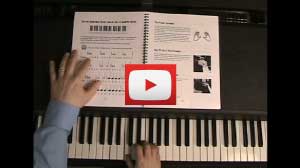Piano Playing Technique
Over the last few centuries, some basic principles of piano playing technique have developed. Unfortunately, many pianists never learn these basic concepts, which can dramatically improve a player's sound and "feel" for the music. Though this page is intended for the pianist who maybe more of an intermediate or advanced player, the beginner will find it advantageous to try to develop these concepts early on.
The Piano Players's Apparatus
The piano player's apparatus includes levers (bones) and joints.
The Levers:
- The fingers
- The hands
- The forearms
- The upper arms
- The torso
The Joints:
- The knuckles
- The wrists
- The elbows
- The shoulders
The pianist creates sound by moving:
- the fingers from the knuckles
- the hands from the wrists
- the forearms from the elbows
- the upper arms from the shoulders
Finger action, the first on the list, is the most important aspect on the above list. It is the basis of piano playing technique.
Wrist action is important for quick, light staccato and rapid octaves.
Elbow action is for rocking the forearms when playing tremolos.
Shoulder action is essential for moving the whole arm and hand for fortissimo chords. Unlike the other three actions above, which are muscular activities, this technique calls for relaxed muscles and using the weight of the arm.
Basic Piano Playing Technique
Basic piano playing technique calls for minimized arm action, relying on the finger movement. Fingers are placed on the keys, and the arm is slightly raised and then relaxed. The finger presses the note down, with the added weight of the relaxed arm. In effect, the finger is supporting the arm on the key. As the different fingers play different notes, the weight of the arm is passed from finger to finger smoothly. This helps to make a full "singing" tone, and allows for minute control of dynamics (volume). This technique helps melodies to sound "alive."
Minimized finger action calls for the fingers to be constantly on the keys, ready to play. Finger strength and independence development is essential for playing passages with even attack and tone. The rotation of the hand enables the fingers to play passages with that even attack and tone.
A supple wrist helps to create a smooth, clean musical phrase. Begin the phrase with the wrist at keyboard level, then raise as you play through the phrase, lowering the wrist towards the end of the phrase. A sideways wrist helps with playing broken chords, extended chords and arpeggios.
A stiff wrist is needed to play percussive, staccato chords. Otherwise the wrist should remain supple.
For playing light, quick octaves, the wrist must be flexible for the quick up and down movement. A fixed wrist and arm movement are combined for forte octave passages.
The Piano Player's Sense of Touch
Piano students can avoid many difficulties by properly developing a sense of touch. By learning to recognize intervals on the staff and then knowing what that distance feels like, the student can learn to avoid the habit of constantly looking down at the keys and then up at the music. This looking "down - up" creates hesitation in the performance, and many students begin to rely on a habit of partly memorizing the piece. The only time the student should need to look at the keys is for wide leaps of more than an octave.
Practicing scales and arpeggios helps the fingers to know where they need to go for melodies and chords.
Start Playing Piano Today with the Piano Guide Quick Start Course!
Easy to follow step-by-step lessons designed for adult beginners. The next best thing to private lessons!
What You'll Learn:
- Notes on the piano/keyboard
- Proper fingering
- C major scale
- Chords
- How to read music
- And much more!

Video lessons - watch as I play everything for you.

